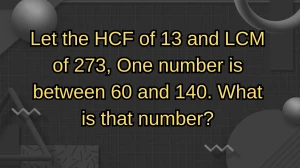A Sum of Rs.900 amounts to Rs.950 in 3 years at Simple Interest. If the interest rate is increased by 4%, it would amount to how much?
by
Updated Jun 26, 2024

A Sum of Rs.900 amounts to Rs.950 in 3 years at Simple Interest. If the interest rate is increased by 4%, it would amount to how much?
Principal (P) = Rs. 900
Amount (A) = Rs. 950
Time (T) = 3 years
Interest rate initially (R) needs to be calculated.
Simple Interest (SI) is calculated as
SI = A − P
Therefore, SI = 950 − 900 = Rs. 50
Using the formula for simple interest
SI = PRT/100
R = (SI x 100)/(P x T)
R = (50 x 100)/(900 x 3)
R = 5000/2700
R = 1.85%
If the interest rate is increased by 4%, the new rate R would be
R = 1.85 + 4 = 5.85%
Calculate the new simple interest using the increased rate
SI = (900 x 5.85 x 3)/100
SI = 157.95
Add the new simple interest to the principal amount to find the new amount
A = P + SI
A = 900 + 157.95
A = 1057.95
Therefore, if the interest rate is increased by 4%, the amount would be approximately Rs. 1057.95
What is Simple Interest?
Simple interest is a fundamental concept in finance and mathematics that helps determine the interest earned or paid on a principal amount over a specific period at a fixed rate. It is the interest calculated on the principal amount or initial sum of money, without considering any interest that has been added over time. The formula for calculating simple interest is
SI = (P×R×T)/100
where
- SI is the simple interest
- P is the principal amount
- R is the rate of interest per annum
- T is the time period in years
Principal Amount (P):
This is the initial sum of money that is either invested or borrowed. It is the base amount on which interest is calculated.
Rate of Interest (R):
This is the percentage at which interest is calculated on the principal amount annually. It represents the cost of borrowing or the gain from investing money.
Time Period (T):
This refers to the duration for which the money is borrowed or invested. It is usually measured in years.
Interest Calculation:
Simple interest is simple to calculate as it does not compound. It means the interest is calculated only on the principal amount and remains constant throughout the period.
Rules and Considerations
- Simple interest is calculated at a fixed rate, meaning the rate of interest remains unchanged throughout the period.
- Unlike compound interest, simple interest does not compound, so the interest earned or paid each period is based solely on the principal amount.
- The time frame for calculating simple interest is usually in years, but it can also be adjusted for months or days by converting the time period appropriately.
- Ensure that the rate of interest and time period are in the same units (e.g., both in years) to avoid errors in calculation.




